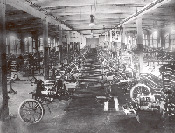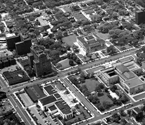
From Motor City to Motor Metropolis: How the Automobile Industry Reshaped Urban America
Living in the Motor City: Autoworkers, Race, and Urban Geography
The flood of newcomers--immigrants and migrants alike-- wholly transformed the city's landscape. Although most immigrant groups lived scattered about the city (ethic neighborhoods were never as homogeneous as many believed them to be), ethnic restaurants, shops, and churches tended to cluster together. Polish, German, and Italian immigrants pooled their resources and built grand churches, many of which were architecturally reminiscent of those in their home countries. One group of new city residents, however, stood apart. Blacks--who were closed out of nearly all white neighborhoods--lived together in close proximity, largely in older, deteriorating central neighborhoods that had fallen out of fashion among whites. Real estate agents refused to show houses in "white" neighborhoods to blacks (unless they were deemed "blighted" or "transitional" neighborhoods that were expected to lose white population). Blacks who attempted to cross the city's invisible racial boundaries regularly faced violence. The result was the creation of two separate cities, one black and one white.
Many newcomers to the city chose neighborhoods that were convenient to their workplaces. Little frame houses and bungalows crowded the streets around big plants, like the Dodge Main plant in Hamtramck, which employed over 30,000 workers at its peak. Many Ford employees could walk to the company's first plants on Piquette Street or in Highland Park. But with the advent of motorized transportation--cars, trolleys, and buses--auto workers no longer had to live in the shadow of the city's plants. Growing numbers chose to live in residential neighborhoods distant from the smoke, fumes, and noise of the huge auto factories. Over the course of the twentieth century, the city's blue-collar population decentralized.
The neighborhoods that autoworkers chose were not, however, random. Chrysler workers were more likely to live on the city's east side, where most Chrysler plants were located. Ford and General Motors workers were more likely to live on the west side, where bus routes led directly to their plants. Auto manufacturers did not, for the most part, did not build planned communities for their workers, like the Sparrow's Point community built by U.S. Steel near Baltimore, Pullman on Chicago's south side near the railroad car manufacturing plant, or Cudahy, the meatpackers' company town outside Milwaukee. Only Ford helped construct housing for its workers--but on a very small scale. In one experiment in Northville, then a small town northwest of Detroit, Ford tried to create a small community of skilled artisans, but it was short-lived. More successful was Ford's subsidized suburban community for blacks in Inkster, what was then a semi-rural area west of the city.
The impact of the car on Detroit's landscape was most visible from the air. Imagine yourself in a small plane or in a hot-air balloon flying over the city in 1940 or 1950. For miles in every direction, a low rise city sprawled outward. Houses were laid out in neat grids, spreading monotonously outward block by block in an endlessly repeating pattern. Also striking when viewed from above (at least on a spring or summer day when the air was not clogged with smoke and coal dust) was how green the city was, particularly in contrast to the large industrial cities of the east coast, which were much more densely built up. In New York, workers lived in cramped tenements and apartment buildings; in Philadelphia, they lived in tiny rowhouses, often on treeless streets overshadowed by red-brick factories and warehouses. In Detroit, by contrast, two-thirds of the structures were detached, single family homes and another fifth were two-family homes, nearly all of them with gardens and yards. Rowhouses, high rise apartments, and tenements were rarities in the Motor City.
By the mid-twentieth century, Detroit was a city of blue-collar home owners. Already by the 1910s and 1920s, many factory workers used their earnings to build their own homes or to buy one of the small wood or brick bungalows that sprung up virtually overnight on the city's open land. Rates of homeownership skyrocketed, particularly after World War II. Union-negotiated wage and benefit packages made auto work more secure than ever and allowed auto workers to join the ranks of mortgage holders. And after the New Deal, white workers got access to federally-backed mortgages and loan guarantees through the Federal Housing Administration, the Home Owners' Loan Corporation, and, if they had served in the military, the Veterans Administration. With few exceptions, these loan programs excluded African Americans and residents of racially diverse neighborhoods: federal policy deemed those neighborhoods "risky" and seldom covered home loans there. As a result, far fewer blacks, even relatively well-paid black autoworkers, could own their own homes.
Not all auto workers wore blue collars. As the auto industry grew over the course of the twentieth century, it became increasingly bureaucratic. No industry offered a better case study of what mid-twentieth century social observers called the "organization man," corporate paper pushers who had made it into the middle-class through discipline and conformity. With its enormous, pyramid-shaped bureaucracies, the auto industry included tens of thousands of middle-rank managers, designers, and engineers, thousands of upper level managers and supervisors, and hundreds of top-level officials. Serving the corporate headquarters of the major automobile companies was a phalanx of attorneys, advertising executives, and even industrial physicians and psychologists. Flush with the wealth generated by auto production, these white collar workers began to buy homes and move into neighborhoods that were increasingly distant from the blue-collar workers beneath them in the corporate hierarchy. (By contrast, in nineteenth century industrial cities, workers and managers tended to live in closer proximity).
By the 1920s, Detroit's rapidly-growing elite began moving to sections of the city remote from the factories, to outlying city neighborhoods like Rosedale Park, English Village, and Palmer Woods, and increasingly to new suburbs. On the curvilinear streets of Birmingham, Bloomfield Hills, and the Grosse Pointes, leading auto executives built mock French chateaux, southern-style plantation houses, Tudor manors, and staid New England colonials. Ford built his vast estate, Fair Lane, in suburban Dearborn, in an eclectic European style, replete with vaulted ceilings, carved paneling, and leaded glass. Middle managers spread out over the metropolitan area, particularly to new suburbs like Southfield, Livonia, Farmington, and Sterling Heights. Suburban builders scrambled to meet their demand for modern, substantial houses architecturally and physically distant from the city. Oakland County, north of Detroit, with its gently rolling countryside and profusion of small lakes, became the community of choice for many auto executives. By the second half of the twentieth century it was one of the wealthiest counties in the United States, a place profoundly shaped by the concentration of auto industry derived wealth.
<<Previous Section - Next Section>>
Becoming the Motor City: Immigrants, Migrants, and the Auto Industry
Living in the Motor City: Autoworkers, Race, and Urban GeographyBuilding the Motor Metropolis: Automobiles, Highways, and Sprawl
Moving Out: Decentralization and the Decline of Urban Factories
Downsizing: Depopulation, Disinvestment, and the Fate of the City
Complete Text Printable View
Sociological Department Housing
About the Project | Credits | Contact Us | Student & Teacher Resources | Site Map
©2004 Automobile in American Life and Society








